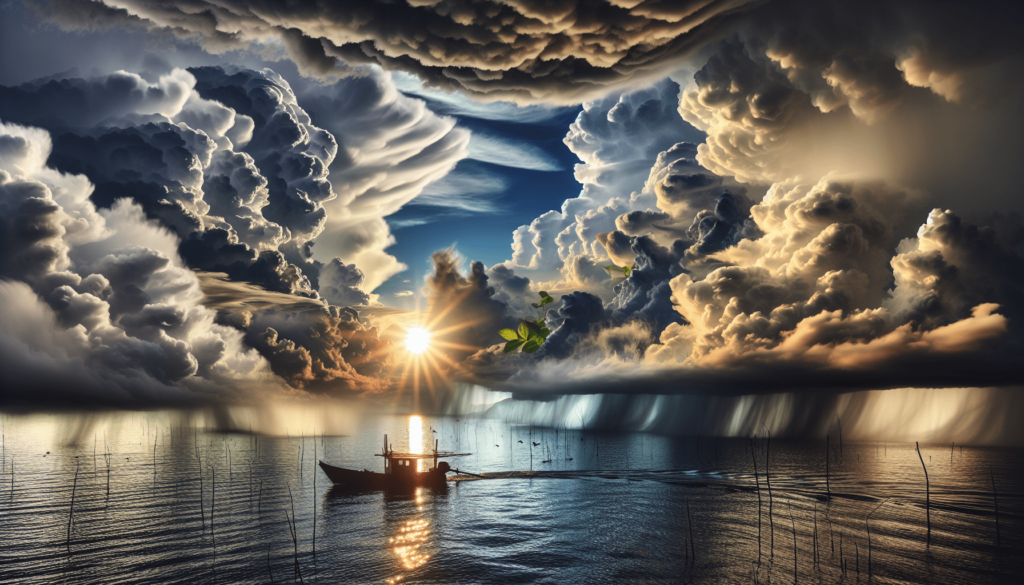Embarking on a fishing trip can be one of the most soothing and exhilarating experiences, especially when you’ve got the perfect weather on your side. “Understanding Weather Conditions and Their Impact on Fishing” walks you through how different weather patterns can significantly influence your fishing success. From the serene calm of a clear, sunny day to the unpredictable challenge of a sudden storm, this article demystifies how these conditions affect the underwater world. Whether you’re a seasoned angler or just dipping your toes into the world of fishing, gaining insight into how weather plays into your aquatic adventure will undoubtedly enrich your experience and potentially amplify your catches.

The Basics of Weather and Fishing
When you’re planning a fishing trip, understanding the key weather elements can significantly improve your chances of a successful outing. The weather affects not just your comfort and safety but also the behavior of fish, making it a critical aspect of fishing strategy.
Understanding the key weather elements
The primary weather elements that influence fishing include barometric pressure, temperature, wind, rain, and storms. Each of these factors can alter the underwater environment, affecting where fish might be located and how active they may be. Keeping an eye on these elements before and during your fishing trip can give you insights into the best times and places to fish.
The role of barometric pressure in fishing
Barometric pressure—essentially the weight of the atmosphere—can influence fish behavior significantly. Fish are sensitive to changes in pressure, which can affect their buoyancy and feeding habits. Understanding how changes in barometric pressure can influence fish activity is key to choosing the right time to go fishing.
Temperature influences on fish behavior
Temperature has a direct impact on the metabolism and activity levels of fish. Warm water can increase a fish’s metabolic rate, leading to more active feeding. Conversely, cold water may slow down their metabolism and reduce their need to feed. Knowing the preferred temperature range for the species you’re targeting is crucial.
How wind affects fishing conditions
Wind can influence water currents and surface conditions, which in turn affects fish distribution. It can also impact your casting and how well you can control your boat or fishing line. Understanding wind patterns and learning how to use them to your advantage—or minimize their disruptive effects—can enhance your fishing experience.
Barometric Pressure and Fishing Success
The relationship between barometric pressure and fishing success is a topic of keen interest for many anglers. Knowing how to read pressure changes and adapt your strategies can be the difference between an empty cooler and a full one.
High vs. low pressure systems
Generally, high-pressure systems are associated with fair weather, but can make fish less active and more difficult to catch. Low-pressure systems, which often lead to overcast skies and stormy weather, can stimulate fish into feeding frenzies, making them easier to catch.
Best fishing times related to barometric pressure changes
The periods just before a pressure change, as a low-pressure system moves in, can be some of the best times to fish. Fish can become more active in anticipation of the changing conditions, offering anglers a prime window of opportunity.
The pressure drop, fish activity, and angler strategy
A dropping barometer, indicating an approaching storm or rain, can lead to increased fish activity. As an angler, this is a perfect time to be on the water, ready to take advantage of the heightened feeding behavior. Adjusting your strategy to target feeding fish can yield significant catches during these periods.
Temperature plays a fundamental role in the behavior and location of fish, affecting where you’ll find them at any given time of the year.
Water temperature vs. air temperature
While air temperature influences your comfort during a fishing trip, it’s the water temperature that matters more for the fish. Fish are ectothermic, meaning their body temperature is regulated by their environment. As the water temperature changes, so does their behavior.
Seasonal patterns and fish location
As seasons change, so do water temperatures, leading fish to migrate to areas where they can find their preferred temperature range. This could mean moving between depths or different areas of a water body as they seek out optimal conditions for feeding and spawning.
Temperature preferences for different fish species
Different species of fish thrive in different temperature ranges. Cold-water species like trout and salmon prefer cooler temperatures, while warm-water species like bass and catfish are more active in warmer waters. Understanding the temperature preferences of your target species can guide you to the best fishing spots.
Wind and Its Effects on Fishing
Wind can be both a challenge and an ally in fishing, depending on its direction and strength.
Wind direction and fish distribution
Wind can push water and surface food, influencing the distribution of fish. For example, fish might follow drifting plankton and baitfish pushed by wind toward a shore or bank, creating prime fishing spots downwind.
How wind speed changes water conditions
Strong winds can stir up the water, increasing oxygen levels and potentially encouraging fish to become more active. However, too much wind can also create rough conditions, making fishing difficult and potentially dangerous.
Strategies for fishing on windy days
On windy days, positioning yourself with the wind at your back can aid casting distance and accuracy. Seeking sheltered spots or using heavier tackle can also help mitigate the effects of wind, making your fishing trip more productive and enjoyable.

Rain, Storms, and Fishing Opportunities
Rain and storms can dramatically affect water conditions and fish behavior, but they also create unique fishing opportunities.
Rainfall’s impact on water bodies and fish behavior
Rain can cool water temperatures, increase water levels, and wash nutrients and insects into rivers and lakes, stimulating fish activity. Fishing just before or after a rainstorm can be particularly effective as fish respond to these changing conditions.
The aftermath of storms and fishing strategies
After a storm, waters might be murkier and carry more debris, but they can also be teeming with active fish. Using brightly colored or noisy lures can help attract fish in these stirred-up conditions.
Lightning safety while fishing
Your safety is paramount. If a storm brings lightning, it’s critical to get off the water immediately. Remember, no catch is worth risking a lightning strike.
The Moon, Tides, and Fishing
The moon’s phases and the resulting tides can have a significant impact on marine and estuary fishing, influencing fish activity and feeding patterns.
Lunar phases and their influence on fish activity
The gravitational pull of the moon generates tides, creating movements of water that can stimulate fish to feed more actively. Many anglers find fishing to be best during the full moon and new moon phases when tides are strongest.
Understanding tides and the best times to fish
High and low tides can concentrate fish in specific areas, making them easier to target. Generally, fishing can be most productive in the hours leading up to and just after high or low tide.
Moonrise and moonset: Taking advantage of peak biting times
In addition to tides, moonrise and moonset are often associated with increased fish activity. Planning your fishing trips around these times can enhance your chances of success.
Cloud Cover and Visibility
Cloud cover and visibility can influence fish behavior and your fishing strategy, particularly in terms of lure selection and presentation.
Cloudy vs. clear skies: How light penetration affects fish
Cloud cover can reduce light penetration, making fish less wary and more likely to explore open waters. Clear conditions, conversely, might push fish into deeper or more sheltered areas.
The role of visibility in predator and prey interactions
Visibility affects how well fish can see prey—and how well they can be seen. In lower visibility, fish might rely more on vibration and scent to locate food, influencing your choice of lures or bait.
Adapting lure selection and color based on cloud cover
On cloudy days, using brighter or more vibrantly colored lures can make them more visible to fish. In clear conditions, more natural, subdued colors might be more effective as they mimic the fish’s natural prey more closely.
Seasonal Weather Patterns and Fishing
Seasonal changes bring about significant shifts in weather patterns, which in turn affect fish behavior and habitat preference.
Spring fishing: Transition and spawning behaviors
Spring marks a time of transition and increased fish activity as water temperatures rise. Fish move into shallower areas to spawn, making them more accessible to anglers. This is an excellent time to target species like bass and crappie.
Summer patterns: Thermocline and surface activity
During the summer, the formation of a thermocline—a distinct temperature layer in deeper water—can concentrate fish at certain depths. Surface feeding, particularly in the early morning and late evening, can also provide exciting top-water action.
Fall turnover: Finding fish in changing conditions
The fall turnover, when the upper and lower layers of a lake mix, eliminates the thermocline and redistributes oxygen and nutrients, causing fish to move. This can be a challenging time, but it also presents opportunities to catch fish as they adjust to these conditions.
Winter ice fishing: Safety and strategy
Winter offers the unique challenge and reward of ice fishing. Safety should be your top priority, with an emphasis on understanding ice conditions and using appropriate gear. Fish tend to be less active but can still be caught by targeting areas around underwater structures and using smaller, more subtly presented baits.
Advanced Weather Tools for Anglers
Today’s technology offers anglers advanced tools to plan their fishing trips around the weather with remarkable precision.
Using weather apps and websites for planning
Numerous weather apps and websites provide up-to-the-minute forecasts, including details on barometric pressure, temperature, wind, and precipitation. Utilizing these tools can help you select the best days and times to hit the water.
Satellite and radar imagery for anglers
Satellite and radar imagery can offer insights into cloud cover, incoming weather systems, and even help predict fish movements. Understanding how to interpret this data can add a powerful tool to your fishing arsenal.
Understanding weather forecasts and fishing reports
Combining weather forecasts with local fishing reports can provide a comprehensive view of what to expect on your fishing trip. This information can guide you in choosing the right location, time, and tactics for the conditions.
Environmental and Ethical Considerations
As anglers, it’s essential to recognize the impact of weather changes on fish habitats and embrace sustainable fishing practices to protect these ecosystems.
The impact of weather changes on fish habitats
Climate change and extreme weather events can have significant impacts on fish populations and aquatic habitats. Being aware of these changes and understanding their implications is crucial for conservation-minded anglers.
Promoting sustainable fishing practices
Practicing catch and release, being mindful of local regulations, and avoiding overfishing are all ways to ensure future generations can enjoy fishing as much as we do today.
The role of anglers in conservation and reporting unusual conditions
Anglers often serve as the eyes and ears on the water, and reporting unusual conditions or fish behaviors can help manage and protect aquatic ecosystems. Your observations can contribute to conservation efforts and help maintain the health of our waterways and fish populations.
By understanding and respecting the complex interplay between weather conditions and fish behavior, you can enhance your fishing experiences, improve your success rates, and contribute to the stewardship of our precious aquatic resources. Happy fishing!


